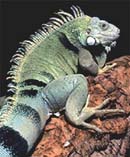|
Reptiles are air-breathing, cold-blooded vertebrates that have skin covered in scales as opposed to hair or feathers. Reptiles have been around for 300 million years, and during the age of the dinosaurs, they ruled the Earth. 
Those days are long gone, and those giants have vanished, but some 6,500 species of reptiles still thrive today. Crocodiles, snakes, lizards, water dragons, iguana, turtles, and tortoises are all reptiles. Most reptiles live on land, and most lay eggs.
They inhabit every continent except Antarctica. Reptiles include turtles, snakes, crocodiles, and lizards. They can be as small as the dwarf gecko (less than an inch long) or as big as the saltwater crocodile, which can weigh more than a ton.
 The Mohave Green Rattlesnake is pictured, and is the type of snake that does not make a good pet. It is deadly. All reptiles have scales, but some are too small to be seen. Reptiles are ectothermic (their body temperature is regulated by their environment). Most lay eggs, but a few give birth to live young. The Mohave Green Rattlesnake is pictured, and is the type of snake that does not make a good pet. It is deadly. All reptiles have scales, but some are too small to be seen. Reptiles are ectothermic (their body temperature is regulated by their environment). Most lay eggs, but a few give birth to live young.
 Amphibians , such as frogs, toads, salamanders, newts, and gymnophiona, are cold-blooded animals that metamorphose from a juvenile, water-breathing form to an adult, air-breathing form. Typically, amphibians have four limbs. Unlike other land animals , amphibians lay eggs in water, as their fish ancestors did. Amphibians are superficially similar to reptiles. Amphibians , such as frogs, toads, salamanders, newts, and gymnophiona, are cold-blooded animals that metamorphose from a juvenile, water-breathing form to an adult, air-breathing form. Typically, amphibians have four limbs. Unlike other land animals , amphibians lay eggs in water, as their fish ancestors did. Amphibians are superficially similar to reptiles.
 Amphibians lead double lives—one in water and one on land. Many begin life with gills, then develop lungs as they age. They are vertebrate animals that include frogs, toads, salamanders, and newts. They are cold-blooded, using the environment to regulate their body temperature. Early amphibians were the first animals to leave the sea and venture onto land, forming a crucial link from fish to terrestrial reptiles. Mudpuppies, also called waterdogs, are one of only a few salamanders that make noise. Amphibians lead double lives—one in water and one on land. Many begin life with gills, then develop lungs as they age. They are vertebrate animals that include frogs, toads, salamanders, and newts. They are cold-blooded, using the environment to regulate their body temperature. Early amphibians were the first animals to leave the sea and venture onto land, forming a crucial link from fish to terrestrial reptiles. Mudpuppies, also called waterdogs, are one of only a few salamanders that make noise.
There are more than 6,000 species of amphibians on Earth, including frogs, toads, salamanders, and newts. One-third of amphibians are threatened with extinction.
For most amphibians, life begins in the water—the young have gills and lack legs when they hatch from eggs laid in the water. They metamorphose, growing legs and changing in other ways to live on land. The word "amphibian" comes from Greek—both lives. Amphibians became the first vertebrates to live on land, and like their "cold-blooded" reptile relatives, depend on external energy sources (such as the sun) to maintain their body temperatures.
|